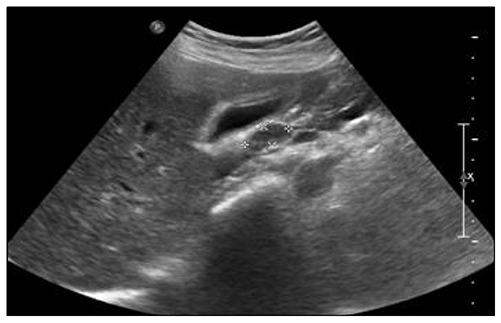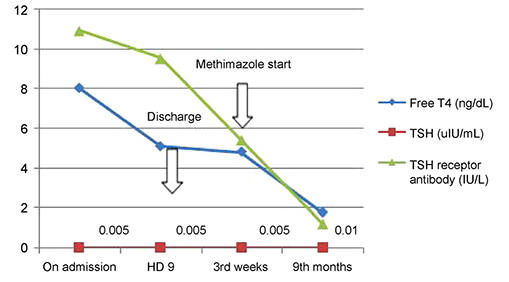Korean J Gastroenterol.
2018 Jun;71(6):354-358. 10.4166/kjg.2018.71.6.354.
A Case of Graves' Disease Accompanied with Acute Hepatitis A Virus Infection
- Affiliations
-
- 1Department of Internal Medicine, Hallym University College of Medicine, Anyang, Korea. miunorijw@hallym.or.kr
- 2Department of Internal Medicine, Seoul Women's Hospital, Incheon, Korea.
- KMID: 2414462
- DOI: http://doi.org/10.4166/kjg.2018.71.6.354
Abstract
- Concurrent presentation of acute hepatitis A virus (HAV) infection and Graves' disease has not been reported in literature worldwide. Although there is no well-established mechanism that explains the induction of Graves' disease by HAV to date, our case suggests that HAV infection may be responsible for inducing Graves' disease. A healthy 27-year-old female presented fever, palpitation, and diarrhea, and she was subsequently diagnosed as acute HAV infection. Concurrently, she showed hyperthyroidism, and the diagnosis was made as Graves' disease. She had never had symptoms that suggested hyperthyroidism, and previous thyroid function test was normal. Acute HAV infection was recovered by conservative management, however, thyroid dysfunction was maintained even after normalization of liver enzymes. Methimazole was used to treat Graves' disease. We report a case of concurrent acute HAV infection and Graves' disease in a patient without preexisting thyroid disease. This suggests that HAV infection may be a trigger for an autoimmune thyroid disease in susceptible individuals.
Keyword
MeSH Terms
Figure
Reference
-
1. Yoon EL, Sinn DH, Lee HW, Kim JH. Current status and strategies for the control of viral hepatitis A in Korea. Clin Mol Hepatol. 2017; 23:196–204.
Article2. Ertem D, Acar Y, Pehlivanoglu E. Autoimmune complications associated with hepatitis A virus infection in children. Pediatr Infect Dis J. 2001; 20:809–811.
Article3. Płoski R, Brand OJ, Jurecka-Lubieniecka B, et al. Thyroid stimulating hormone receptor (TSHR) intron 1 variants are major risk factors for Graves' disease in three European Caucasian cohorts. PloS One. 2010; 5:e15512.
Article4. Weetman AP. Graves' disease. N Engl J Med. 2000; 343:1236–1248.
Article5. Brent GA. Environmental exposures and autoimmune thyroid disease. Thyroid. 2010; 20:755–761.
Article6. Brix TH, Kyvik KO, Hegedüs L. What is the evidence of genetic factors in the etiology of Graves' disease? A brief review. Thyroid. 1998; 8:727–734.
Article7. Dittfeld A, Gwizdek K, Michalski M, Wojnicz R. A possible link between the Epstein-Barr virus infection and autoimmune thyroid disorders. Cent Eur J Immunol. 2016; 41:297–301.
Article8. Jin HY, Kang SM, Kim SY, Park JH, Baek HS, Park TS. A case of Graves' disease combined with hantaan virus infection. J Korean Med Sci. 2009; 24:158–161.
Article9. Yoffe B, Burns DK, Bhatt HS, Combes B. Extrahepatic hepatitis B virus DNA sequences in patients with acute hepatitis B infection. Hepatology. 1990; 12:187–192.
Article10. Cui W, Deng B, Wang W, Liu P. Graves' hyperthyroidism accompanied with acute hepatitis B virus infection: an extrahepatic manifestation. Virol J. 2016; 13:80.
Article11. Pastore F, Martocchia A, Stefanelli M, et al. Hepatitis C virus infection and thyroid autoimmune disorders: a model of interactions between the hostand the environment. World J Hepatol. 2016; 8:83–91.12. Dumoulin FL, Liese H. Acute hepatitis E virus infection and autoimmune thyroiditis: yet another trigger. BMJ Case Rep. 2012; 04. 23. [Epub ahead of print].
Article13. Kong SJ, Min SK, Kim IK, et al. Two cases of acute hepatitis E in patients with hyperthyroidism. Korean J Gastroenterol. 2006; 47:65–71.14. Lai ST, Chiu W. Graves' disease in a chronic hepatitis C patient not receiving interferon therapy. Hong Kong Med J. 1996; 2:104–106.15. Enghofer M, Badenhoop K, Zeuzem S, et al. Fulminant hepatitis A in a patient with severe hyperthyroidism: rapid recovery from hepatic coma after plasmapheresis and total thyroidectomy. J Clin Endocrinol Metab. 2000; 85:1765–1769.
Article16. Inman RD, Hodge M, Johnston ME, Wright J, Heathcote J. Arthritis, vasculitis, and cryoglobulinemia associated with relapsing hepatitis A virus infection. Ann Intern Med. 1986; 105:700–703.
Article17. Pischke S, Hartl J, Pas SD, Lohse AW, Jacobs BC, Van der. Hepatitis E virus: infection beyond the liver? J Hepatol. 2017; 66:1082–1095.
Article18. Tanaka H, Tujioka H, Ueda H, Hamagami H, Kida Y, Ichinose M. Autoimmune hepatitis triggered by acute hepatitis A. World J Gastroenterol. 2005; 11:6069–6071.
Article19. Kyriacou A, McLaughlin J, Syed AA. Thyroid disorders and gastrointestinal and liver dysfunction:a state of the art review. Eur J Intern Med. 2015; 26:563–571.20. Khemichian S, Fong TL. Hepatic dysfunction in hyperthyroidism. Gastroenterol Hepatol (NY). 2011; 7:337–339.
- Full Text Links
- Actions
-
Cited
- CITED
-
- Close
- Share
- Similar articles
-
- Prevention of Viral Hepatitis and Vaccination
- Two Cases of Acute Hepatitis E in Patients with Hyperthyroidism
- A Case of Acute Transverse Myelitis with Hepatitis B Virus Infection
- Pre-S Defective Hepatitis B Virus in Patients with Acute and chronic Hepatitis B Virus Infection
- Symptomatic Hepatitis A Virus Infection in a Newborn




